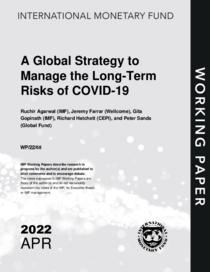A global strategy to manage the long-term risks of COVID-19

Agarwal, Ruchir ; Gopinath, Gita ; Farrar, Jeremy ; Hatchett, Richard ; Sands, Peter
IMF - Washington, DC
2022
26 p.
epidemic disease ; risk management ; economic recession ; disease control ; sustainable development ; health policy ; economic policy
IMF Working Paper
WP/22/68
Risk assessment and risk management
https://www.imf.org/-/media/Files/Publications/WP/2022/English/wpiea2022068-print-pdf.ashx
English
Bibliogr.
"The pandemic is not over, and the health and economic losses continue to grow. It is now evident that COVID-19 will be with us for the long term, and there are very different scenarios for how it could evolve, from a mild endemic scenario to a dangerous variant scenario. This realization calls for a new strategy that manages both the uncertainty and the long-term risks of COVID-19. There are four key policy implications of such as strategy. First, we need to achieve equitable access beyond vaccines to encompass a comprehensive toolkit. Second, we must monitor the evolving virus and dynamically upgrade the toolkit. Third, we must transition from the acute response to a sustainable strategy toward COVID-19, balanced and integrated with other health and social priorities. Fourth, we need a unified risk-mitigation approach to future infectious disease threats beyond COVID-19. Infectious diseases with pandemic potential are a threat to global economic and health security. The international community should recognize that its pandemic financing addresses a systemic risk to the global economy, not just the development need of a particular country. Accordingly, it should allocate additional funding to fight pandemics and strengthen health systems both domestically and overseas. This will require about $15 billion in grants this year and $10 billion annually after that."
Digital
The ETUI is co-funded by the European Union. Views and opinions expressed are however those of the author(s) only and do not necessarily reflect those of the European Union or the ETUI.